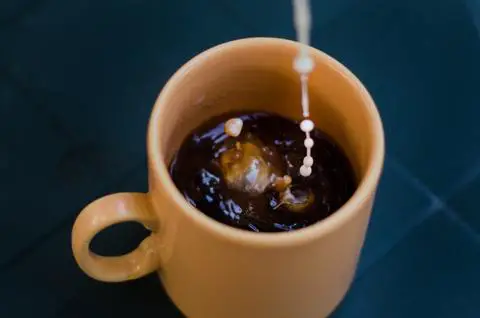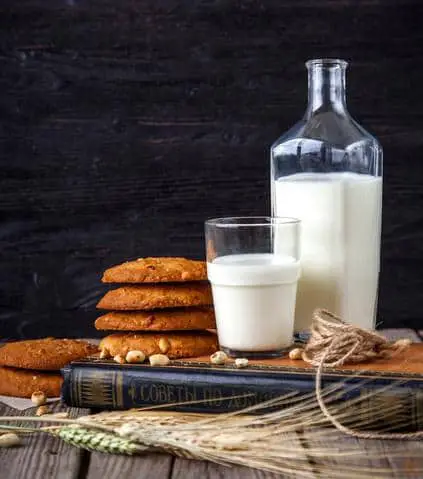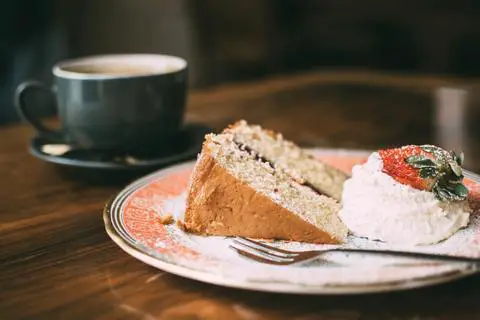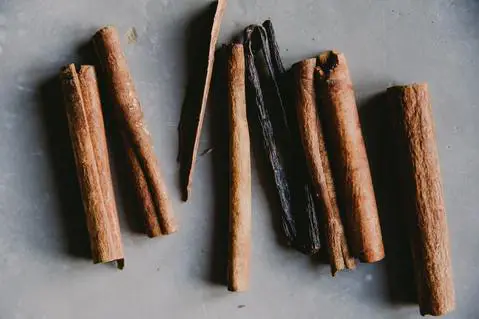Although many coffee purists discourage people from adding anything to black coffee, others enjoy enhancing their cup of Joe with milk or non-dairy creamer.

Why does milk pair so well with coffee? Fats added from milk significantly alter the coffee’s texture, making it denser and giving it a velvet-like smoothness. Milk proteins soften the bitterness of the coffee by binding themselves to tannins and other polyphenolic elements. While they are healthy for your body, tannins contain an astringent flavor that can be quite detractive from the taste of coffee.
Coffee’s brightness/acidity is also lessened by milk proteins. Much like the way milk fats bind to tannins, milk proteins react to chlorogenic acids (CGA), which are largely responsible for the vibrancy of the drink. After a CGA reaction, coffee doesn’t taste nearly as acidic. Acidity is an often sought-after coffee characteristic, but not every connoisseur enjoys an overtly bright cup of coffee. Hence, the addition of milk is a suitable way to minimize the acidity of a brew. Furthermore, flavored creamers are capable of supplementing the coffee’s taste.
This article will go over the available options for enhancing your cup. Maybe next time you’re making a fresh cup, you’ll try out a new creamer!

For your information, if you click on a product on Jayarrcoffee.com and decide to buy it, we may earn a small commission.
Table of Contents
Creamer/Milk Types
Although a majority of people in the West add cow’s milk to coffee automatically, there are other options available.
Cow’s Milk

The most frequently used type of milk poured into coffee is cow’s milk. It adds a certain amount of sweetness and thickness to your coffee, contingent on the milk’s freshness and its fat content.
Skim Milk vs. Whole Milk – the Importance of Fat Content
As with the milk you purchase to consume, the content of milk fat can substantially affect both the texture and taste of your coffee.

Baristas generally use whole milk unless specifically told otherwise. Whole milk holds more weight than any other type of milk, and the amount of fat in it ranges between 3.25 and 4%. If you want your coffee’s texture to be thicker, whole milk is just the thing you need.
Skim milk, in contrast, is capable of preserving your coffee’s original texture. However, skim milk produces the longest-lasting and best foam. It’s also a lot sweeter than its counterpart.
Getting Denser: Cream Types
Half-&-Half
Developed by Boutwell Dairy’s William A. Boutwell in Florida, half cream and half milk (a.k.a. half-&-half) started being distributed in 1927. Ever since, it’s become a frequently used creamer throughout America. Half-&-half has a fat content of approximately 12%, making it substantially thicker than whole milk.
Light Cream
If half-&-half or whole milk doesn’t produce the thickness you’re partial to, consider slightly increasing the fat content with light cream. This kind of cream has a fat content of approximately 20%. If you are calorie conscious, be mindful that increasing the fat content will invariably increase the number of calories per unit volume.

Whipping Cream (Light)
Starting at this point, these creamer choices are a substantially richer and thicker in contrast to the examples listed above. Light whipping cream is comprised of approximately 30% fat.
Whipping Cream (Regular)
Whipping cream usually has a milk fat content of 35%, but slightly varies product-to-product.
Heavy Cream
The heaviest and thickest choice you can use is heavy cream. As the name implies, it is the densest option with at least a 38% fat content. It’s quite rich and all you need is a very small amount.
Dairy-Free Choices
Milk proteins and fats are molecular structures that impact the overall taste of the coffee. Milk with a high fat and protein content has the biggest effect on taste. In contrast, non-dairy variations of milk, such as coconut, rice, and soy, are mostly comprised of water and lack the same amount of protein and fat that cow’s milk has. As such, they won’t improve coffee flavor in the same way cow milk can through binding fats and proteins with compounds in the coffee. Cafes and coffee shops will usually provide a range of non-dairy options. The most frequently consumed types of non-dairy creamers are made of:
- Soy
- Cashews
- Coconuts
- Oats
- Almonds
- Creamers (non-dairy)

Almond milk is our favorite choice, because it contains a nutty, sweet, and light taste that doesn’t detract from the coffee itself. Almond milk is usually available in most supermarkets and it contains a fair balance of protein, carbohydrates, and fat compared to other non-dairy options. However, flavor will vary significantly between brands, so you’ll need to try out a bunch of versions to determine which one you like best.
Popular Dairy-Free Creamers
So Delicious Dairy-Free Coconut Milk Creamer

For people in search of a dairy, soy, or nut-free creamer without sacrificing flavor and creaminess, So Delicious is worth a try. Each tablespoon of So Delicious Coconut has just 10 calories and is made from all-natural ingredients including cane sugar and organic coconut. So Delicious is also available in hazelnut and French vanilla varieties.
Silk Dairy-Free Soy Creamer

As one of the original non-dairy alternatives, Silk is ideal if you’re not too fond of the nutty flavor that accompanies most nut-based creamers. Each tablespoon is 30 calories and is made from cane sugar, palm oil, and soy milk. Silk’s creamers are also available in hazelnut and vanilla varieties.
Califia-Farms Dairy Free Better Half and Creamer

This sugar-free choice is our favorite unsweetened creamer. The combination of coconut cream and almond milk produces a balanced combination that is only 7.5 calories per teaspoon. Califia Farms offers unsweetened and original versions of their product in addition to dulce de leche, Mexican cocoa, Irish cream, pecan caramel, hazelnut, and vanilla flavors.
Coconut Butter

Combine a couple teaspoons of some coconut butter with your coffee to create a silky, creamy, and frothy drink with a fuller mouthfeel. There aren’t any other ingredients in coconut butter- the beauty is in its simplicity. Each tablespoon contains roughly 100 calories.
CoffeeMate

CoffeeMate is quite the ubiquitous dairy-free creamer. There are also 19 different flavors to choose from, including hazelnut, vanilla caramel, and French vanilla.
CoffeeMate does not contain dairy, lactose, cholesterol, or gluten, and each tablespoon contains approximately 20 calories. Their creamers can also be purchased in powder form or premixed liquid and in single-serve pouches. As a powder, CoffeeMate is shelf stable.
What’s in a Creamer?
Most people begin their day with coffee, topping it with a tasty velvet–flavored creamer with no idea what is in it. But, upon closer inspection of the ingredients listed, you’ll often find a bunch of strange ingredients,, such as:
- Artificial flavoring
- Mono-and diglycerides
- Dipotassium phosphate
- Sodium caseinate
Fortunately, creating a creamer of your own is a surprisingly easy endeavor that allows you to avoid these mystery ingredients. Best of all, you only need a handful of ingredients that are probably already in your pantry and it only takes a few minutes to make.
Instead of grabbing a fake-tasting sugary creamer, spend some time every few weeks or so to make a delectable homemade creamer of your very own- one you’ll have no hesitations about using when making your coffee each morning.
Making a Flavored Creamer for Your Coffee
Creamer Base Creation
Regardless of what flavors you want, your homemade creamer base will always remain the same. Better yet, only a couple of common ingredients are required.

To make your creamer, combine a condensed milk can (sweetened; 14 ounces) with 1 ¾ cup (14 ounces) of cream or milk of your choosing (a ratio of 1:1). For a non-dairy or vegan alternative, you can use condensed (sweetened) coconut milk along with a non-dairy milk of your choosing.
Although condensed milk is used as a core part of the creamer, feel free to experiment with different ingredients to suit your nutritional and taste preferences. Try using different types of milk- including soy, almond, 2%, skim, half-and-half, whole, and even cream- to produce various textures and flavors.
Combine the milk with the condensed milk in a small bowl, whisking vigorously. Alternatively, you can add them to a jar (with a lid) that you’re able to shake well. Homemade creamer should be refrigerated in a plastic container, an airtight jar, or a recycled creamer container for up to 14 days.
If you would rather use artificial or an alternative form of sugar in your base (perhaps to reduce your sugar intake), you can create your own version of condensed milk (sweetened) by whisking two cups of whole milk together in a heated saucepan with your choice of sugar substitute (3/4 of a cup). Stir over a medium-low setting, letting the mixture simmer for approximately half an hour and whisking frequently until the quantity of milk has reduced by half. After reduction, take the saucepan off the stove and stir some butter in (about four tablespoons) before completely cooling.
Flavor Experimentation
Once your creamer base is in the books, you can start experimenting with different flavors using a couple of different methods. When crafting a flavored creamer for the first time, syrups or extracts can easily be added to the base to create a final, delicious beverage.
If dry ingredients are to be added, such as spices, or more dense ingredients like honey, then it’s important to make sure that the additions will be completely integrated into your creamer. To achieve this, pour the ingredients and some base cream or milk into a pot. Heat the pot up so that the ingredients completely dissolve into the mixture. Then, let the liquid cool off before integrating it with your condensed milk–as well as the outstanding cream or milk–to complete your creamer. Although this is an optional step, it will stop the creamer from developing a grain-like texture.

Although the choices for flavor mixtures are virtually unlimited, a number of ingredients we encourage you to try are maple syrup, pumpkin pie spice, instant coffee, cinnamon, cocoa powder, chocolate syrup, almond extract, and vanilla extract. Add between one and two tablespoons (individually) for each ingredient so that the flavor isn’t overpowering. After trying it out once, you can then calibrate it to your tastes.
Below are a few examples you can use as a guide:
Vanilla chai: honey (two tablespoons) + vanilla extract (two teaspoons) + cinnamon (one teaspoon) + cardamom (half teaspoon).
That Almond Candy Bar: almond extract (one teaspoon) + chocolate syrup (two tablespoons) + coconut extract (one teaspoon).

Hazelnut: hazelnut extract (two teaspoons)
Chocolate raspberry: raspberry syrup (two tablespoons) + cocoa powder (two teaspoons).
Pumpkin spice: maple syrup (two tablespoons) + vanilla extract (one teaspoon) + pumpkin pie spice (one teaspoon) + cinnamon (half teaspoon).

Nutella: chocolate syrup (two tablespoons) + hazelnut extract (two teaspoons).
Peppermint mocha: peppermint extract (one teaspoon) + chocolate syrup (one tablespoon) + cocoa powder (one teaspoon).
Cinnamon coffee cake: vanilla extract (two teaspoons) + cinnamon (two teaspoons).

Dark chocolate: chocolate syrup (two tablespoons) + cocoa powder (one teaspoon).
Milk chocolate: chocolate syrup (two tablespoons) + vanilla extract (one teaspoon).
French vanilla: vanilla extract (two teaspoons).

Gingerbread: maple syrup (one tablespoon) + vanilla extract (one teaspoon) + cinnamon (half teaspoon) + allspice (1/8 teaspoon).
These homemade creamers do not contain artificial ingredients and you’ll be surprised how simple and quick it can be to make your own from scratch.
